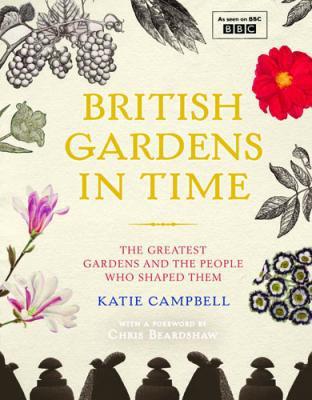
There is nothing I enjoy more than a bit of history and when it’s coupled with horticulture I am a very happy person. So I was thrilled to be offered a review copy of British Gardens in Time; the book which accompanies the new BBC series.
The book, and television series, showcase four well-known British gardens with each representing a key stage in the progression of British horticultural design. As a bonus the book, written by Katie Campbell, starts with a short history of British Gardens. We are taken on a gallop through history from the Roman influences, through the lack of any real garden interest in the medieval times to the gardens Elizabeth I’s courtiers built to try to woo her. I particularly appreciated the approach taken by Campbell throughout the book which embraces all aspects of the horticultural world not just the design. I spent some time a year or two ago learning about garden design history and it was quite clear that the development of garden design not only occurred due to a need for lords to impress and show off their wealth but also due to the plant introductions that were coming in from new colonies overseas. You have to understand the whole context of the environment the garden was created in, as well as the background of its creator, to fully appreciate the garden.
The four gardens: Stowe, Biddulph Grange, Nymans, and Great Dixter are presented mainly from a historical perspective. However, the history of the development of each garden is given set within the context of other garden design and influences. In the case of Stowe we learn how the development of the garden reflects its owner’s Lord Cobham’s changing political views and criticism of Walpole, the then Prime Minister. At this time many large gardens including allegorical statues and buildings which would have conveyed a hidden message to visitors; something we now find hard to understand.
Biddulph was built on the profits of the industrial revolution by James Bateman a keen botanist and sponsor of many plant hunters. Therefore this section of the book explores the ‘cult’ of the Victorian plant hunters but also, interestingly to me, the work of female botanical artists many who remain anonymous. I have found this period of horticultural history fascinating for some time far more than the development of the landscape garden under Capability Brown’s artistic hand such as at Stowe. I suspect that it appeals to the romantic in me, all those exciting stories of exploration, as well as to my fascination with plants and where they come from. Bateman was into orchids, they were his first love, and it is interesting to learn how obsessive and single-minded these collectors and plant hunters could be. Campbell recounts how some plant hunters collected every single specimen of a plant they would carry and destroyed the remainder so only they had the plant. It seems that in some cases their single-mindedness destroyed whole colonies although I suppose when you consider the Victorian approach to wild game hunting we shouldn’t be surprised that this arrogant approach pervaded other aspects of life.
I haven’t read the final two chapters on Nymans and Great Dixter but if they follow the style of the first half of the book and the quality of the television series episode on Great Dixter that was shown last week they should be excellent.
I like the way the book uses the four very different gardens to explore the subject of garden/horticultural history including other developments such as the early plant nurseries, plant hunters, plant magazines, the acceptability of lady gardeners, the foundation of the RHS and National Trust and the influence of other contemporary gardeners and designers.
I found Campbell’s writing style easy and accessible; although relaying a lot of information in a fairly compact style it has a good flowing narrative to it. The photographs of the gardens by a range of photographers are needless to say wonderful but it is the photographs of the owners and occupiers, particularly for the latter gardens, and the botanical drawings that I really loved.
I would recommend this book for anyone who is in love with the world of horticulture, as I am. It is like reading about your heroes and heroines with a touch of plant porn thrown in – what more could I ask for!

